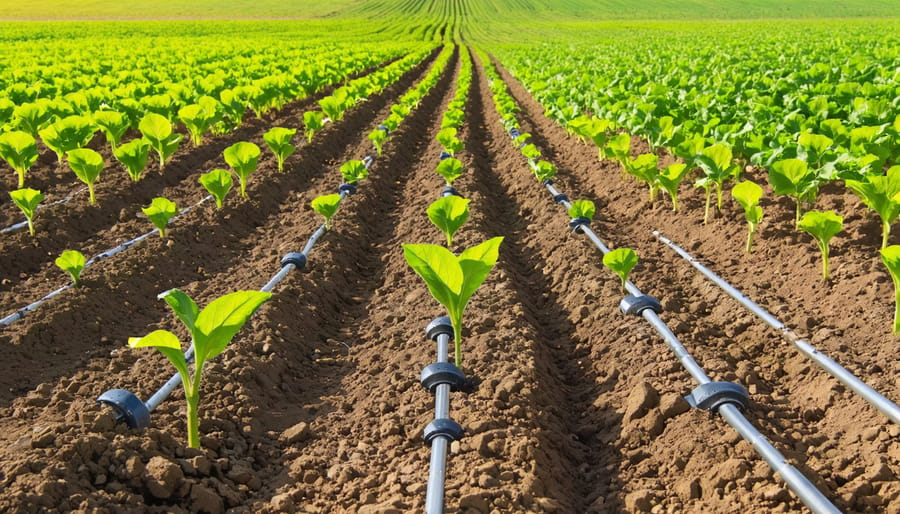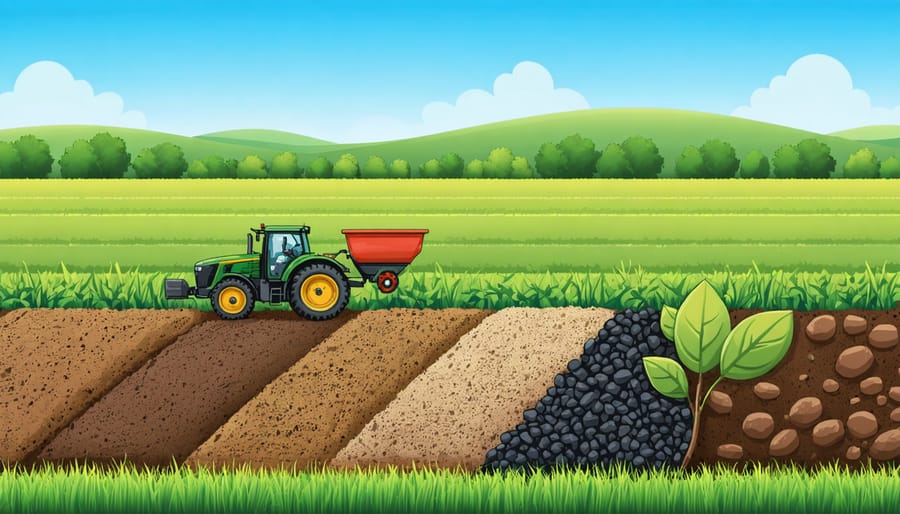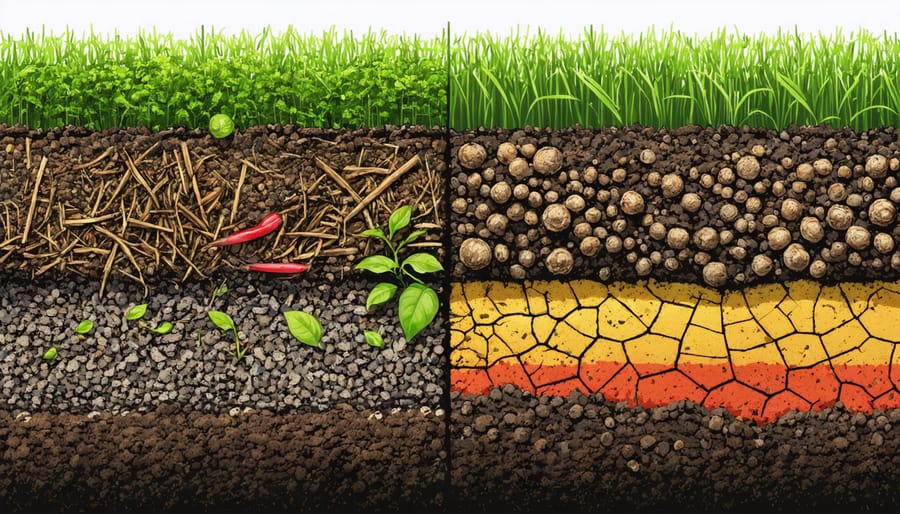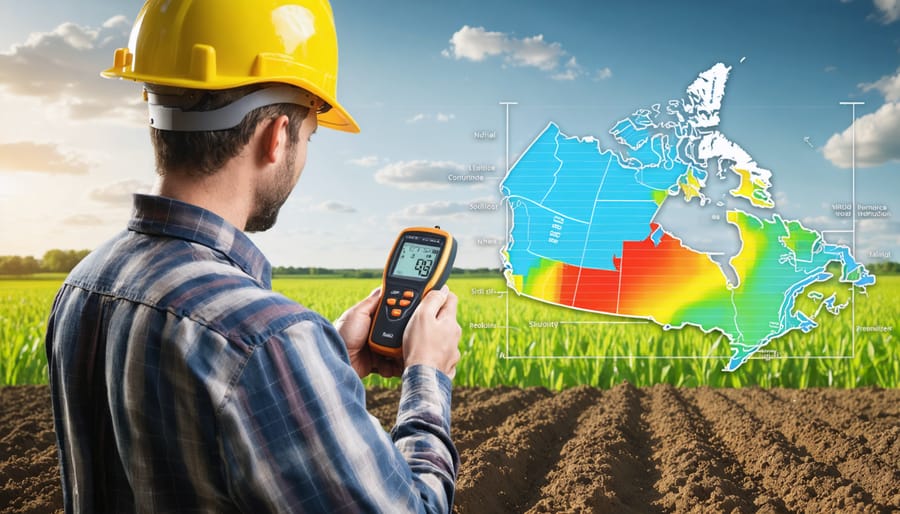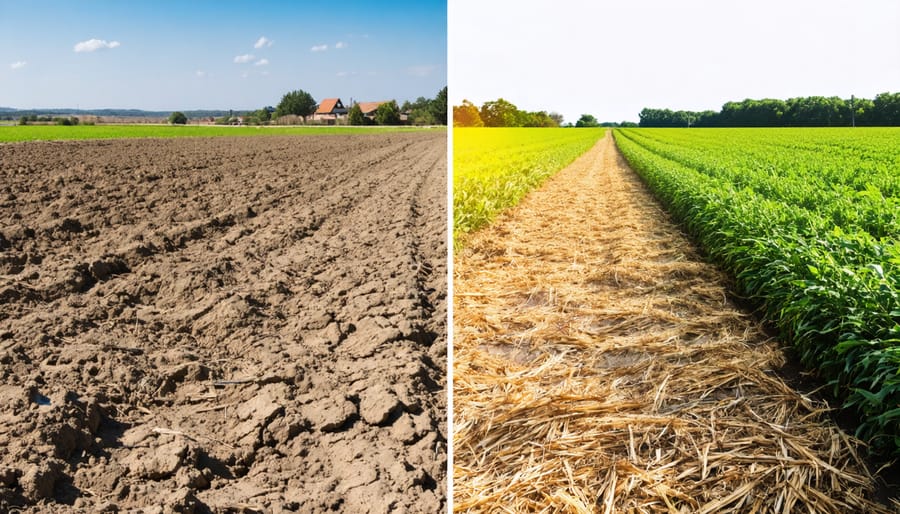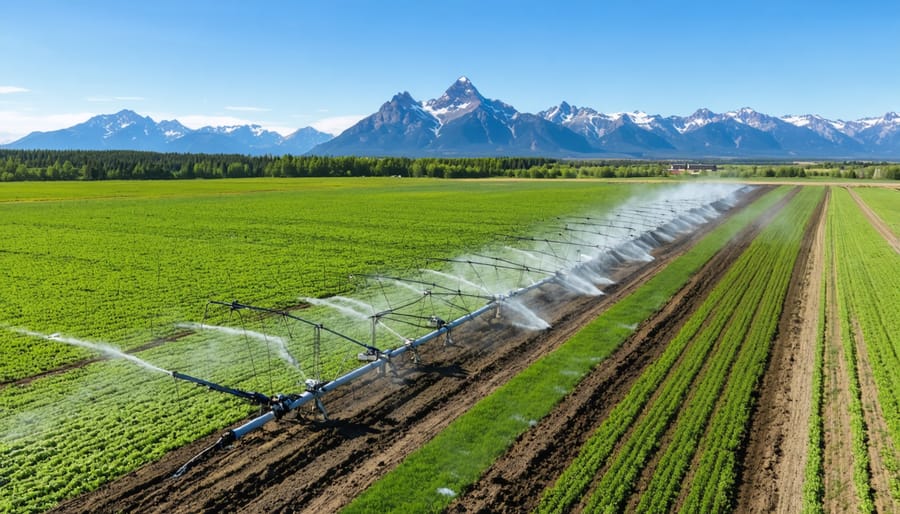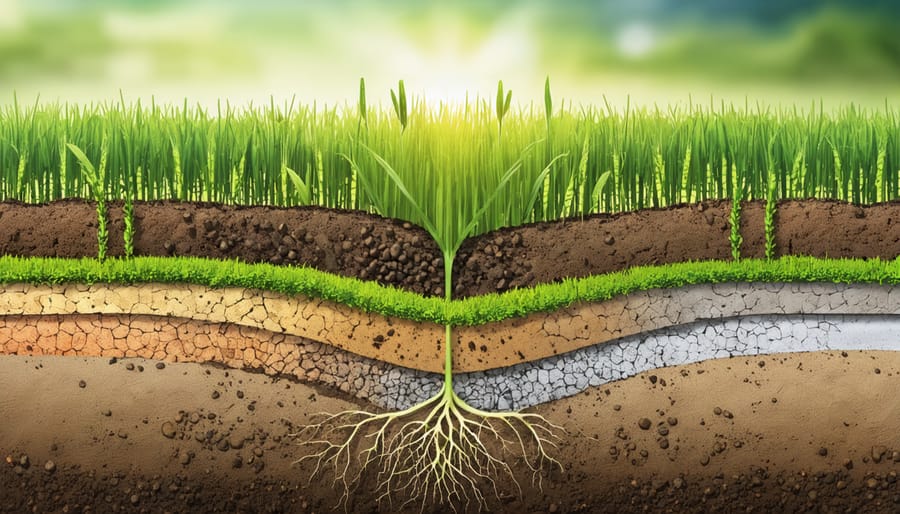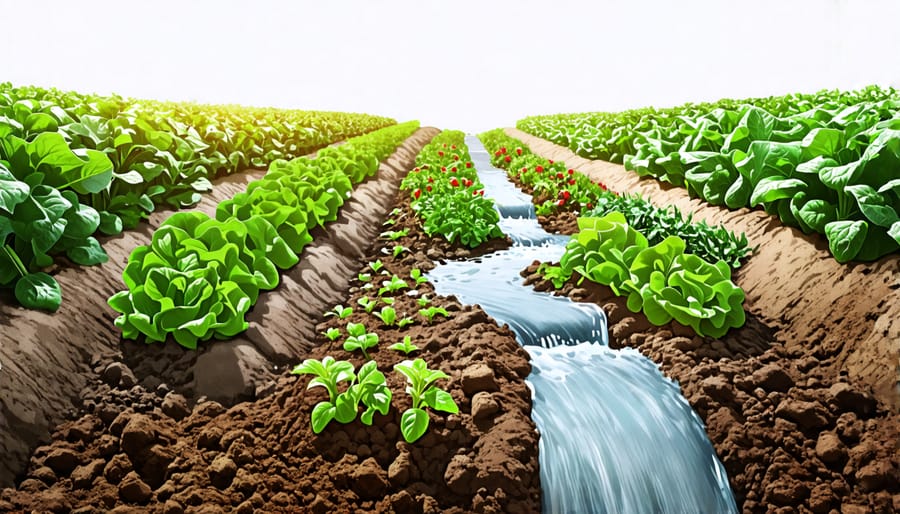Managing clay soil irrigation demands precision and specialized techniques that respect its unique water-holding properties. Throughout Alberta’s agricultural regions, farmers have discovered that the dense, compact nature of clay soil requires a strategic approach to prevent waterlogging while ensuring optimal moisture distribution.
Drip irrigation emerges as the most effective method for clay soils, delivering water directly to plant roots at 2-4 litres per hour – slow enough for proper absorption without surface pooling. This controlled approach has helped Prairie farmers reduce water usage by up to 40% while maintaining crop yields, particularly in regions experiencing increasingly dry summers.
Whether you’re working with small-scale market gardens or extensive field crops, understanding clay soil’s slow permeability rate of approximately 1-5mm per hour transforms irrigation from a challenge into an opportunity. Modern soil moisture sensors and smart irrigation controllers now enable farmers to precisely match water application to their soil’s specific infiltration rates, preventing the common issues of runoff and soil compaction that once plagued clay soil management.
By implementing these science-backed irrigation strategies, Canadian farmers are not just conserving water – they’re building more resilient and productive agricultural systems that work in harmony with clay soil’s natural properties.
Understanding Clay Soil in Alberta’s Climate
Clay Soil Properties That Affect Irrigation
Clay soil presents unique challenges for irrigation due to its distinctive physical properties. The soil consists of tiny, densely packed particles that create a compact structure, significantly affecting water infiltration and drainage patterns. In Alberta’s agricultural regions, clay soils typically hold more water than sandy or loamy soils, but they release it more slowly to plants.
These soils can retain up to 40% of their volume in water, making them excellent for water storage. However, this high water-holding capacity is a double-edged sword. When dry, clay soil becomes hard and forms cracks, while excessive moisture causes it to become sticky and compact, potentially limiting root growth and nutrient uptake.
The slow permeability of clay soil means water takes longer to penetrate the surface, often leading to pooling or runoff if irrigation isn’t properly managed. Understanding these properties is crucial for developing effective irrigation strategies that work with, rather than against, the natural characteristics of clay soil. This knowledge helps farmers optimize water usage while maintaining healthy soil structure and promoting sustainable crop growth.
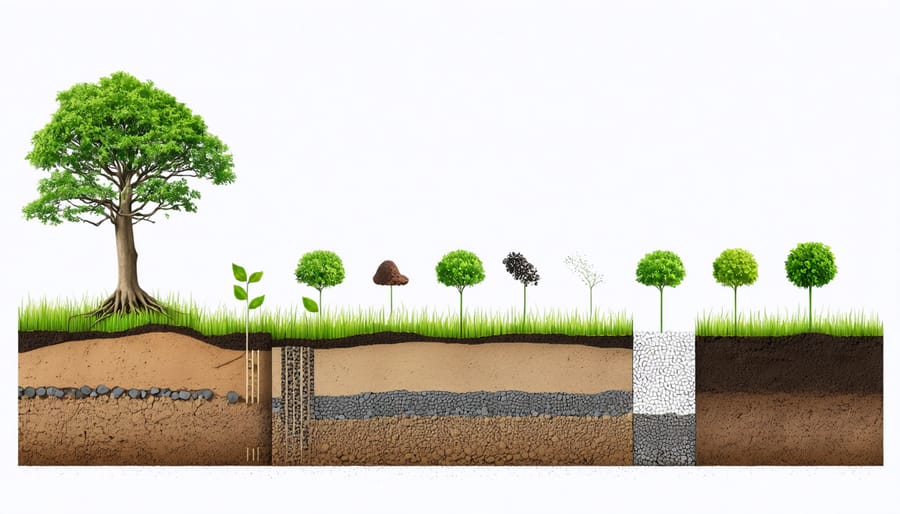
Local Climate Considerations
Alberta’s unique climate presents distinct challenges and opportunities for irrigating clay soil. Our region experiences significant seasonal variations, from hot, dry summers to cold winters, with annual precipitation averaging 350-500mm. These conditions, combined with clay soil’s natural properties, require careful consideration when planning irrigation strategies.
Spring typically brings moisture through snowmelt and rainfall, making it crucial to avoid overwatering during this period. Summer months often demand increased irrigation attention, particularly when managing drought conditions that frequently affect our province. The challenge lies in maintaining consistent soil moisture without creating waterlogged conditions that clay soil is prone to.
Fall irrigation requires special attention as temperatures drop and evaporation rates decrease. Many successful Alberta farmers reduce irrigation frequency during this time while maintaining adequate soil moisture for winter preparation. The region’s freeze-thaw cycles can affect clay soil structure, making it essential to adjust irrigation practices seasonally.
Local agricultural extension services report that successful irrigation in Alberta’s clay soils often involves monitoring soil moisture levels and weather forecasts to optimize watering schedules. This proactive approach helps farmers maintain optimal growing conditions while conserving water resources.
Top-Performing Irrigation Methods for Clay Soil
Drip Irrigation Systems
Drip irrigation stands out as an exceptionally effective solution for clay soil, particularly in Alberta’s diverse climate conditions. This system delivers water directly to the plant roots through a network of tubes and emitters, working harmoniously with clay soil’s natural properties.
The slow and steady water delivery matches clay soil’s gradual absorption rate, preventing the surface pooling that’s common with other irrigation methods. For Alberta farmers, this means better water efficiency and reduced risk of soil compaction, a crucial consideration when working with clay-rich land.
Local farmer Mike Thompson from Lethbridge reports a 30% reduction in water usage since switching to drip irrigation on his clay-soil vegetable farm. “The system lets me control exactly where the water goes, and my plants respond better because they’re getting consistent moisture,” he shares.
Key benefits of drip irrigation for clay soil include:
– Precise water placement that prevents soil crusting
– Reduced weed growth due to targeted watering
– Minimal soil erosion and nutrient leaching
– Lower energy costs compared to sprinkler systems
– Ability to fertigation (applying fertilizer through irrigation)
Installation requires careful planning, with emitters spaced 30-45 centimetres apart for optimal coverage in clay soil. The system works best when combined with mulching, which helps maintain soil moisture and prevent surface hardening.
For best results, operate the system during early morning or evening hours when evaporation rates are lowest. Regular maintenance checks ensure emitters remain clear and functioning properly, particularly important with clay soil’s tendency to cause mineral buildup.
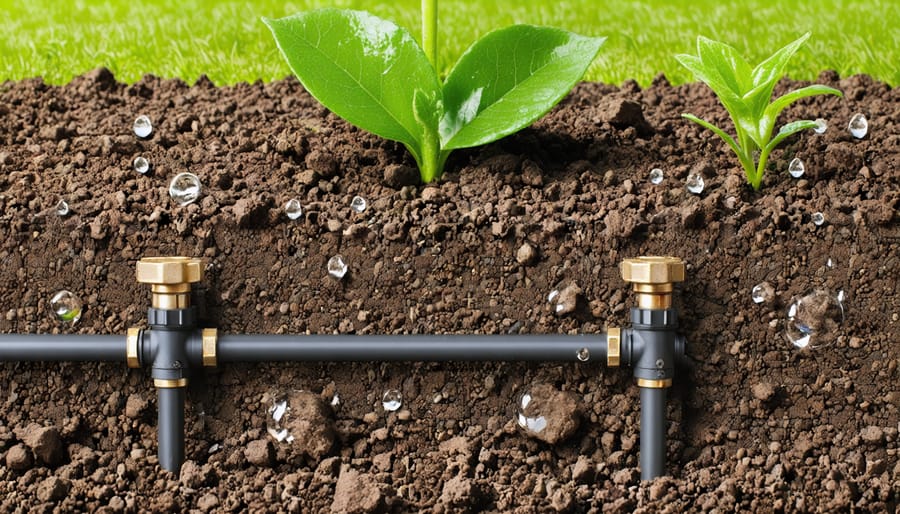
Soaker Hose Solutions
Soaker hoses offer an efficient solution for irrigating clay soil, particularly in Alberta’s diverse climate conditions. These porous hoses deliver water directly to the soil surface at a slow, steady rate that clay soil can effectively absorb, preventing runoff and water waste.
For optimal results in clay soil, position soaker hoses about 5 to 10 centimetres below the soil surface. This depth allows for better water distribution while protecting the hose from UV damage and surface disturbance. Space parallel lines approximately 45 to 60 centimetres apart, accounting for clay soil’s lateral water movement capability.
Local farmer Mike Thompson from Leduc County shares, “I’ve found running my soaker hoses for longer periods at lower pressure – about 10 PSI – gives the best results in our heavy clay soil. It’s cut my water usage by 30% compared to overhead sprinklers.”
To maximize efficiency, consider these practical tips:
– Use a pressure regulator to maintain consistent flow
– Schedule irrigation during early morning hours to reduce evaporation
– Layer organic mulch over the hoses to improve moisture retention
– Install a timer to automate watering sessions
– Check hoses regularly for clogs, especially in areas with hard water
When installing soaker hoses in clay soil, create slight slopes away from plants to prevent water pooling. During initial setup, run the system for about an hour and check soil moisture at various depths to determine optimal watering duration for your specific conditions.
For winter protection in our cold climate, drain and store hoses indoors when temperatures consistently drop below freezing. This extends their lifespan and ensures reliable performance season after season.
Smart Sprinkler Technologies
Today’s modern irrigation techniques have revolutionized how we manage clay soil irrigation through smart sprinkler technologies. These advanced systems combine precision timing with real-time soil moisture monitoring to deliver optimal water distribution while preventing the common issues associated with clay soil irrigation.
At the heart of these systems are soil moisture sensors, typically installed at various depths throughout the field. These sensors continuously monitor soil moisture levels, ensuring water is only applied when necessary. For clay soil, which tends to retain water longer than other soil types, this precise monitoring helps prevent overwatering and soil compaction.
Smart controllers are another game-changing component, allowing farmers to program irrigation schedules based on real-time weather data, soil conditions, and crop requirements. Many Alberta farmers have reported water savings of 30-40% after implementing these systems, while maintaining or improving crop yields.
Weather-based controllers add another layer of efficiency by automatically adjusting watering schedules based on local weather forecasts. These systems can postpone irrigation when rain is predicted or increase watering during hot, dry spells – particularly valuable for managing clay soil’s tendency to crack during drought conditions.
Flow sensors and pressure regulators work together to maintain consistent water distribution and prevent system damage. This is especially important for clay soil, where proper pressure management helps prevent surface runoff and ensures water penetrates the soil effectively.
Many systems now offer mobile connectivity, allowing farmers to monitor and adjust irrigation settings remotely through smartphone apps. This technology has proven particularly valuable during extreme weather events, enabling quick responses to changing conditions.
For best results, consider installing multiple sensors across your field to account for soil variations and ensure uniform moisture distribution. Local agricultural extension services can provide guidance on optimal sensor placement and system configuration for your specific situation.
Optimizing Irrigation Timing and Volume
Seasonal Irrigation Schedules
In Alberta’s distinct climate zones, adjusting your irrigation schedule throughout the growing season is crucial for clay soil management. During spring thaw, typically March to mid-April, limit irrigation to prevent waterlogging as clay soil already retains snowmelt. Once soil temperatures reach 5°C, begin with light, frequent irrigation sessions to support early crop establishment.
Summer irrigation requires careful attention, especially during July and August when evaporation rates peak. For clay soils, implement deeper, less frequent watering cycles – typically every 7-10 days, applying 25-30mm of water per session. This approach encourages deeper root growth and prevents surface crusting common in clay soils.
As autumn approaches, reduce irrigation frequency by about 30% to prepare crops for harvest. In September, maintain soil moisture at 50-60% capacity, adjusting based on crop maturity stages. For winter crops, provide a final deep irrigation in late October to ensure adequate soil moisture before freeze-up.
Monitor soil moisture using tension meters or the simple hand test – if soil forms a firm ball when squeezed, it likely doesn’t need immediate irrigation. Local agricultural extension offices often provide soil moisture monitoring services to help fine-tune your schedule.
Remember that these schedules should be adjusted based on specific crop requirements, local rainfall patterns, and real-time weather conditions. Many Alberta farmers find success by irrigating during early morning hours to minimize evaporation losses and maximize absorption in clay soil.
Water Volume Management
Managing water volume in clay soil requires a careful balance to prevent both underwatering and waterlogging. Our Alberta farmers have found success by implementing precision irrigation practices that account for clay soil’s unique properties.
The optimal water volume typically ranges between 25-30mm per irrigation cycle, applied at a slow rate of 10-15mm per hour. This measured approach allows the water to penetrate the dense clay structure without causing surface pooling. A practical method to determine irrigation timing is the “squeeze test” – take a handful of soil from 15cm depth; if it holds shape but crumbles when poked, it’s at ideal moisture content.
To prevent waterlogging, monitor soil moisture using tensiometers placed at different depths. Maintain soil moisture between -30 and -60 kPa for most crops. Many successful Alberta farmers schedule irrigation based on weekly evapotranspiration rates, typically applying water when 50% of the available soil moisture is depleted.
During spring thaw and after heavy rains, allow for a 24-48 hour drainage period before resuming irrigation. Installing soil moisture sensors at 30cm and 60cm depths helps track water movement and prevents over-saturation. Remember that clay soil holds water longer than other soil types, so adjust your irrigation frequency accordingly, focusing on deeper, less frequent watering cycles.
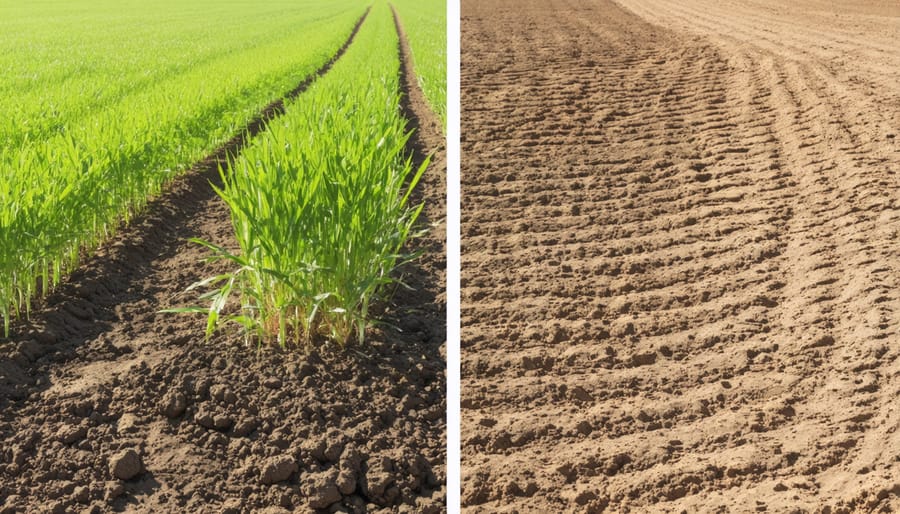
Real Results: Alberta Farm Case Studies
Two Alberta farmers have transformed their clay-heavy fields into productive agricultural land through strategic irrigation choices. Near Lethbridge, Sarah Thompson’s 300-hectare farm showcases the success of subsurface drip irrigation. After installing the system in 2019, she reported a 30% reduction in water usage while increasing crop yields by 25% in her canola fields.
“The key was spacing the drip lines 60 centimetres apart and 35 centimetres deep,” Thompson explains. “This allows for optimal water distribution in our heavy clay soil without creating surface pooling.”
In Red Deer County, Mark Davidson’s market garden operation demonstrates the effectiveness of combining drip irrigation with soil amendments. His system, installed in 2020, features pressure-compensating emitters that maintain consistent flow despite clay soil’s challenging properties. Davidson’s water-efficient setup has reduced his irrigation time by 40% while improving soil structure.
“We’ve integrated wood chip mulch with our drip system,” Davidson notes. “This combination has dramatically improved water penetration and reduced surface crusting common in clay soils.”
Both farmers emphasize the importance of proper system maintenance. Regular flushing of lines and careful monitoring of soil moisture levels have been crucial to their success. Their experiences show that while initial setup costs were significant, the long-term benefits in water conservation and crop productivity made the investment worthwhile for their clay soil operations.
Managing clay soil irrigation effectively is crucial for sustainable farming in Alberta and across Canada. By implementing drip irrigation systems, adjusting watering schedules based on seasonal needs, and maintaining proper soil amendments, you can maximize water efficiency while promoting healthy crop growth. Remember that successful irrigation in clay soil requires patience and consistent monitoring. Start with small changes, measure your results, and adjust your approach as needed. Together, we can build more resilient farming practices that conserve water resources while maintaining productive yields. Consider joining local agricultural networks to share experiences and learn from fellow farmers who have successfully adapted their irrigation methods for clay soil conditions. Your efforts in implementing these practices contribute to both farm sustainability and environmental stewardship.

